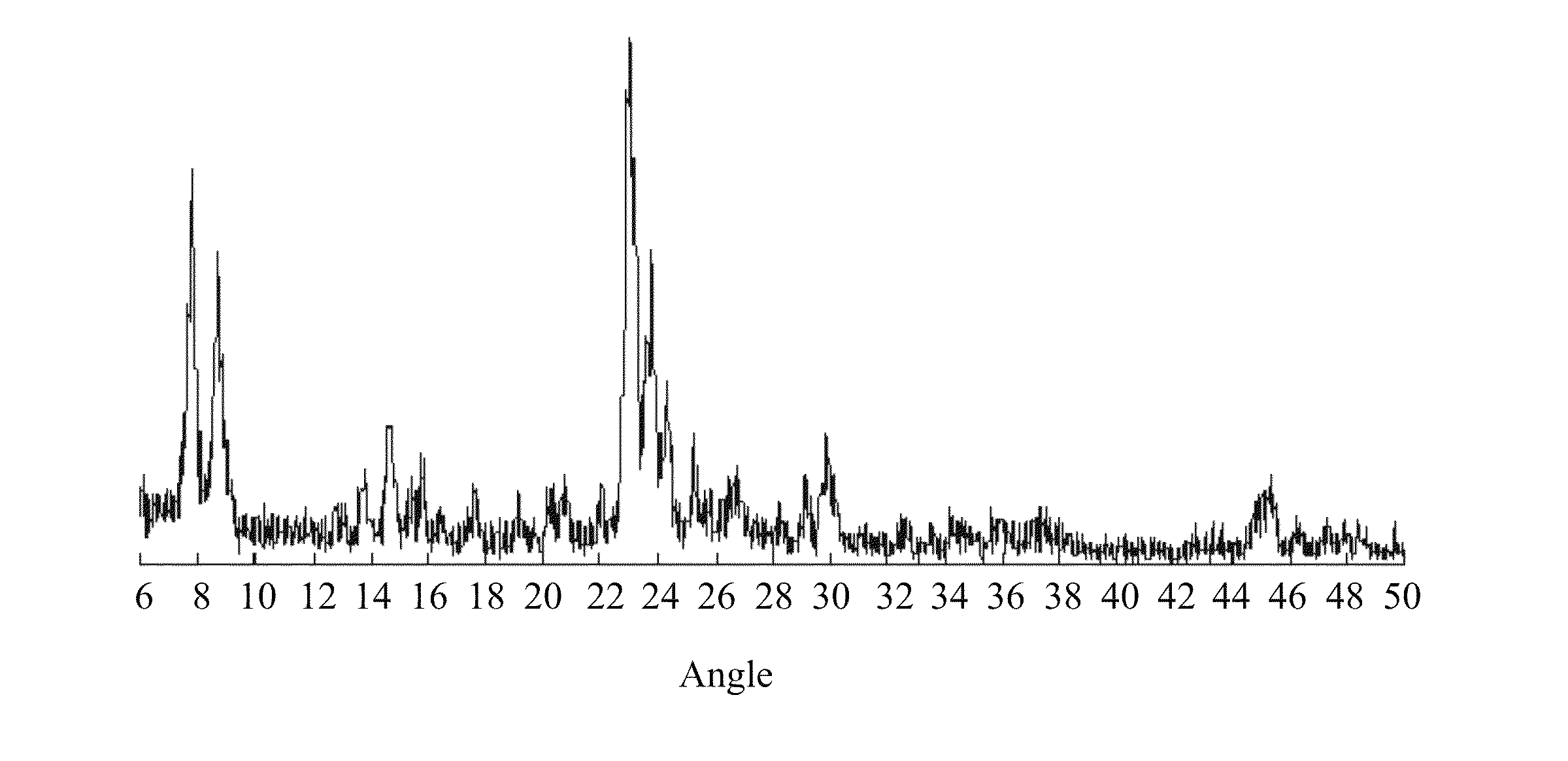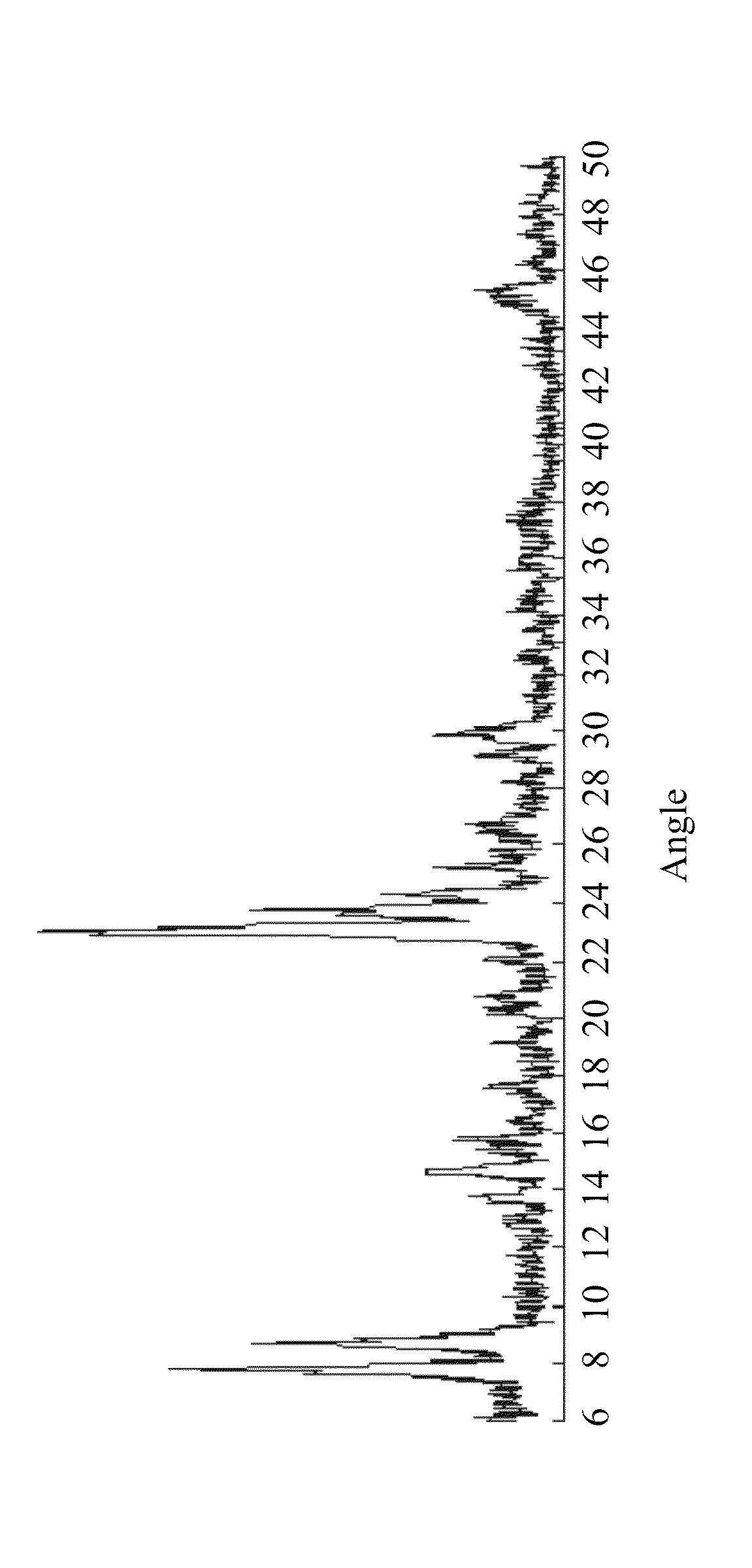Titanium-silicalite molecular sieve, method for preparing the same and method for preparing cyclohexanone oxime using the molecular sieve
a technology of silicon silicon silicalite and molecular sieve, which is applied in the preparation of oximes, physical/chemical process catalysts, ferrosilicates, etc., can solve the problems of inability to improve the use efficiency of hydrogen peroxide for lowering production costs and complicated methods, and achieve high conversion rates, high selectivity, and high use efficiency of hydrogen peroxide
- Summary
- Abstract
- Description
- Claims
- Application Information
AI Technical Summary
Benefits of technology
Problems solved by technology
Method used
Image
Examples
embodiment 1
V-TS-1 Preparation (Catalyst A)
[0030]A flask (500 ml) was nitrogen sealed under vacuum. 1.932 g of tetrabutyl titanate was added into the flask, and then cooled down to 5° C. Upon temperature equilibrium, 30.27 g of tetraethyl silicate was dropped into the flask, and then stirred for 1 hour. 56.5 g (20 wt %) of tetrapropylammonium hydroxide isopropanol solution was dropped into the flask. 0.19 g of vanadyl sulfate hydrate was dissolved in 20 ml of water, and then this solution was dropped into the flask. Then, the mixture was stirred, then heated at 85° C. to remove alcohol, and added with water to form total weight of 100 g, so as to obtain the gel mixture. The gel mixture was sealed in a stainless steel can, and was heated at 180° C. for 120 hours. Then, the solid was separated from the liquid, and was cleaned with pure water to be neutral. The solid was dried at 100° C., and calcined at 550° C. for 8 hours, so as to obtain the catalyst.
embodiment 2
Fe-TS-1 Preparation (Catalyst B)
[0031]A flask (500 ml) was nitrogen sealed under vacuum. 1.98 g of tetrabutyl titanate was added into the flask, and then cooled down to 5° C. Upon temperature equilibrium, 30 g of tetraethyl silicate was dropped into the flask, and then stirred for 1 hour. 56 g (20 wt %) of tetrapropylammonium hydroxide isopropanol solution was dropped into the flask. 0.39 g of ferric chloride hexahydrate was dissolved in 20 ml of water, and then this solution was dropped into the flask. Then, the mixture was stirred, then heated at 85° C. to remove alcohol, and added with water to form total weight of 100 g, so as to obtain the gel mixture. The gel mixture was sealed in a stainless steel can, and was heated at 180° C. for 120 hours. Then, the solid was separated from the liquid, and was cleaned with pure water to be neutral. The solid was dried at 100° C., and calcined at 550° C. for 8 hours, so as to obtain the catalyst. The X-ray spectrum of this catalyst was show...
embodiment 3
Co-TS-1 Preparation (Catalyst C)
[0032]A flask (500 ml) was nitrogen sealed under vacuum. 1.98 g of tetrabutyl titanate was added into the flask, and then cooled down to 5° C. Upon temperature equilibrium, 30 g of tetraethyl silicate was dropped into the flask, and then stirred for 1 hour. 56 g (20 wt %) of tetrapropylammonium hydroxide isopropanol solution was dropped into the flask. 0.0143 g of cobaltous acetate tetrahydrate was dissolved in 20 ml of water, and then this solution was dropped into the flask. Then, the mixture was stirred, then heated at 85° C. to remove alcohol, and added with water to form total weight of 100 g, so as to obtain the gel mixture. The gel mixture was sealed in a stainless steel can, and was heated at 180° C. for 120 hours. Then, the solid was separated from the liquid, and was cleaned with pure water to be neutral. The solid was dried at 100° C., and calcined at 550° C. for 8 hours, so as to obtain the catalyst.
PUM
| Property | Measurement | Unit |
|---|---|---|
| mole ratio | aaaaa | aaaaa |
| molar ratio | aaaaa | aaaaa |
| molar ratio | aaaaa | aaaaa |
Abstract
Description
Claims
Application Information
 Login to View More
Login to View More - R&D
- Intellectual Property
- Life Sciences
- Materials
- Tech Scout
- Unparalleled Data Quality
- Higher Quality Content
- 60% Fewer Hallucinations
Browse by: Latest US Patents, China's latest patents, Technical Efficacy Thesaurus, Application Domain, Technology Topic, Popular Technical Reports.
© 2025 PatSnap. All rights reserved.Legal|Privacy policy|Modern Slavery Act Transparency Statement|Sitemap|About US| Contact US: help@patsnap.com


